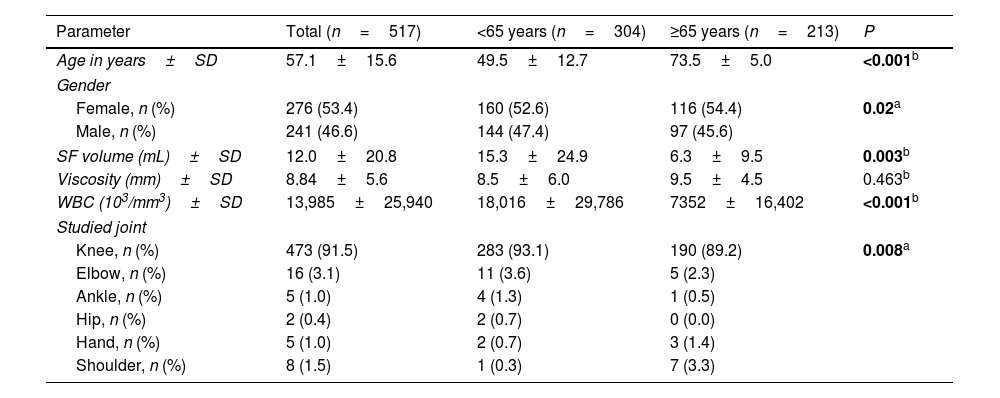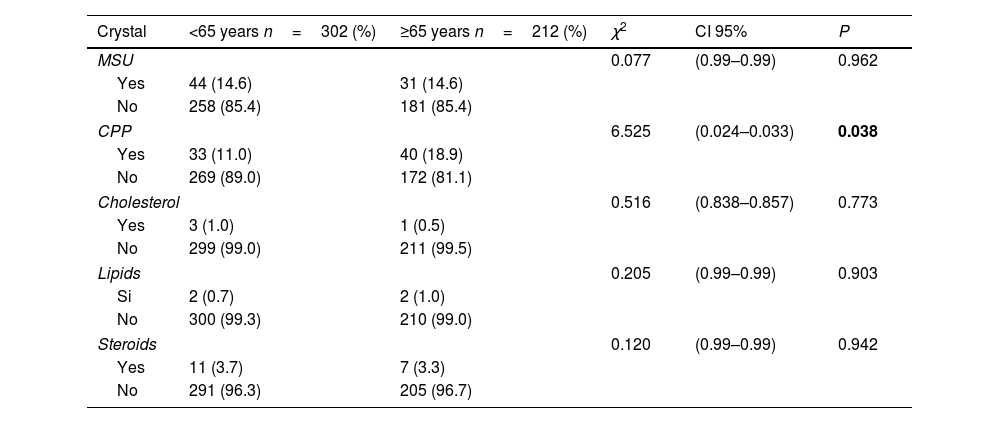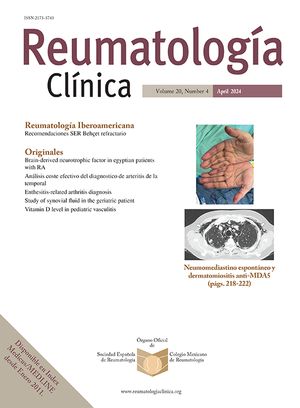The characteristics of synovial fluid (SF) in geriatric patients differ from those in younger patients. In Mexico, epidemiologic data on the incidence of different rheumatic diseases in geriatric patients are scarce.
ObjectiveTo describe the physical characteristics of geriatric SF and the prevalence of crystals in knee and other joint aspirates from patients with previously diagnosed joint disease.
Materials and methodsA retrospective study was performed with a baseline of 517 SF samples between 2011 and 2023. White blood cell count was performed by Neubauer chamber and crystals were identified by polarized light microscopy. Descriptive statistical analysis was performed and prevalence was reported as a percentage.
ResultsThe mean age of the adults was 73.5±5.0 years, 54.4% were women and 45.6% were men. The mean SF volume was 6.3±9.5mL in older adults and 15.3±24.9mL in those younger than 65 years. The mean viscosity in older adults was 9.5±4.5mm and the mean leukocyte count was 7352±16,402leukocytes/mm3. Seventy percent of the older adults’ SFs were referred to the laboratory for osteoarthritis (OA), with lower proportions for rheumatoid arthritis (RA) (14.6%) and gout (5.1%). Of the crystals observed in the geriatric population, 14.6% corresponded to monosodium urate crystals (CUM) and 18.9% to calcium pyrophosphate crystals (CPP).
ConclusionsThe characteristics of LS in older adults were smaller volume, increased viscosity, and non-inflammatory. The main diagnoses were OA, RA, and gout. The crystal content of the SF of the geriatric population corresponded mainly to CPP.
Las características del líquido sinovial (LS) en pacientes geriátricos varían en comparación con pacientes más jóvenes. En México, los datos epidemiológicos sobre la incidencia de diversas enfermedades reumáticas en el paciente geriátrico son escasos.
ObjetivoDescribir las características físicas del LS geriátrico y la prevalencia de cristales en aspirados de rodilla y otras articulaciones de pacientes con enfermedades articulares previamente diagnosticadas.
Materiales y métodosSe realizó un estudio retrospectivo con una base de 517 muestras de LS entre 2011 y 2023. El recuento de glóbulos blancos se realizó con cámara de Neubauer, y los cristales se identificaron por microscopia de luz polarizada. Se realizó un análisis estadístico descriptivo y la prevalencia se reportó como porcentaje.
ResultadosLa edad promedio en los adultos fue de 73,5±5,0 años; el 54,4% fueron mujeres y el 45,6%, hombres. El volumen promedio del LS en adultos mayores fue de 6,3±9,5ml, mientras que en menores de 65 años fue de 15,3±24,9ml. La viscosidad promedio fue de 9,5±4,5mm en los adultos mayores, y una cuenta de 7.352±16.402 leucocitos/mm3. El 70% de los LS de los adultos mayores fueron remitidos a laboratorio por osteoartritis (OA), u una proporción más baja, por artritis reumatoide (AR) (14,6%) y gota (5,1%). En cuanto a los cristales observados en los LS de la población geriátrica, el 14,6% correspondieron a cristales de urato monosódico (CUM) y el 18,9%, a cristales de pirofosfato de calcio (CPP).
ConclusionesLas características del LS en los adultos mayores fueron menor volumen, viscosidad incrementada y no inflamatorios. Los principales diagnósticos fueron OA, AR y gota. El contenido de los cristales en los LS de la población geriátrica correspondió principalmente a CPP.











